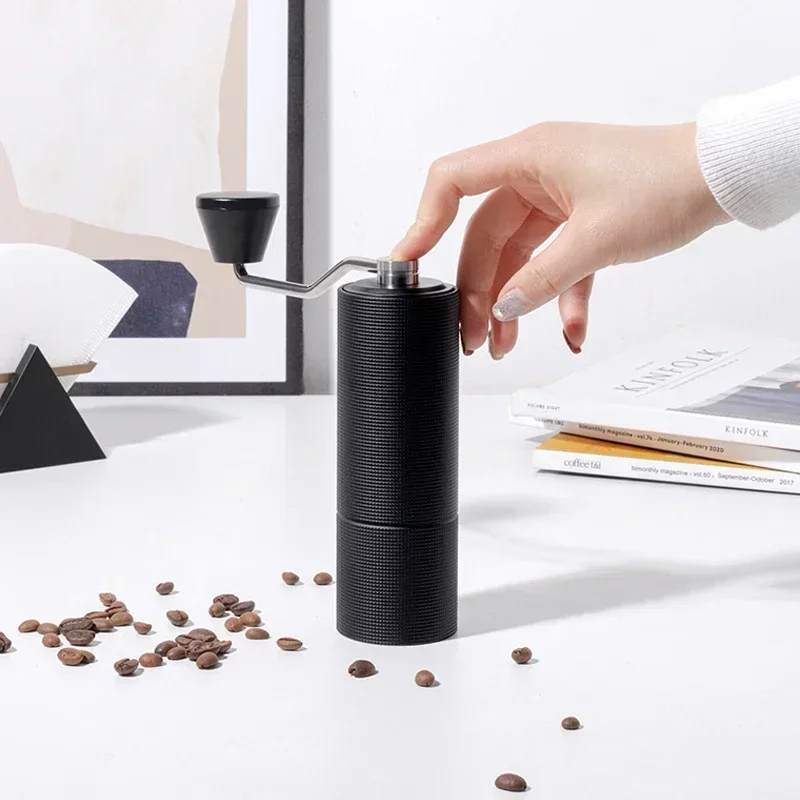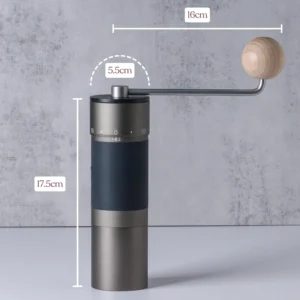Why Grind Size Is the Critical Variable in Crafting Perfect Espresso
When it comes to making exceptional espresso, no other factor impacts your results as dramatically as grind size. This single variable forms the foundation of extraction dynamics and ultimately determines whether your espresso will be memorably delicious or disappointingly flat.
The relationship is direct and powerful: your grind size controls how water interacts with coffee particles, which determines what compounds are extracted, and ultimately defines the flavor profile in your cup. Understanding this relationship transforms your coffee experience, turning ordinary shots into extraordinary ones with rich complexity and perfect balance.
While variables like water temperature and tamping pressure matter, professional baristas always begin their troubleshooting by adjusting grind size. This is because even tiny adjustments to your grind can resolve most flavor issues and dramatically improve extraction quality.
Throughout this guide, we’ll explore the science behind why grind size matters so fundamentally, help you diagnose common taste problems, and provide practical calibration techniques to achieve consistent, delicious results. The journey to espresso mastery begins with fine-tuning espresso grind size to unlock the full potential of your coffee beans.
The Science Behind Extraction: How Grind Size Determines Espresso Character
Surface Area Dynamics: The Foundation of Extraction
At its core, coffee extraction is a surface area game. When you grind coffee beans, you exponentially increase the surface area available for water contact. This transformation is dramatic – a single whole bean might have only a few square millimeters of surface area, while the same bean ground for espresso creates thousands of tiny particles with combined surface area hundreds of times larger.
This increased surface area directly impacts extraction efficiency. Finer grounds expose significantly more coffee compounds to water, allowing for faster, more complete dissolution of flavors. The relationship isn’t linear either – the difference between “fine” and “extra-fine” can double the available surface area, dramatically changing extraction dynamics.
Think of it like sugar dissolving in tea: granulated sugar dissolves much faster than a sugar cube because of its greater surface area, despite being the same substance. Similarly, espresso requires fine grinding to efficiently extract complex flavors in the brief 25-30 second brewing window.
Understanding how coffee grind affects pressure flow is essential for mastering extraction dynamics and achieving consistent results.
Water Flow Physics: Resistance and Contact Time
Grind size creates a direct physical relationship with water flow through the coffee puck. Finer grounds pack together more densely, creating greater resistance to water passage. This resistance is crucial for proper extraction under the standard 9 bars of pressure used in espresso machines.
When grounds are too fine, excessive resistance forces water to seek channels through the puck, resulting in uneven extraction. When too coarse, water rushes through with minimal resistance, causing under-extraction. The sweet spot creates just enough resistance to ensure water makes proper contact with coffee particles while maintaining even flow.
Contact time – how long water interacts with coffee grounds – is directly determined by this resistance. Finer grounds extend contact time by slowing water flow, while coarser grounds shorten it. This time factor is critical because different flavor compounds extract at different rates: acids extract quickly, while bitter compounds require longer exposure.
The quality of your grinder significantly impacts flow dynamics, as the impact of burr shape on espresso consistency reveals. Precision-engineered burrs create uniform particles that pack evenly and create consistent resistance throughout the coffee puck.
The Extraction Balance: Finding the Sweet Spot
The ultimate goal in espresso preparation is achieving balanced extraction – the ideal dissolution of flavor compounds that creates harmonious taste. This balance occurs within a relatively narrow extraction percentage range, typically 18-22% of the coffee’s soluble mass.
Below this range, under-extraction leads to sour, underdeveloped flavors as insufficient compounds are dissolved. Above it, over-extraction introduces excessive bitter compounds that overpower pleasant flavors. Grind size serves as the primary control mechanism for hitting this sweet spot.
The challenge lies in the fact that different compounds extract at different rates. Acids and fruity notes extract early, while sweetness emerges in the middle, and bitter compounds predominate later. The perfect grind size enables extraction to progress just far enough to capture the desirable compounds while limiting the undesirable ones.
This extraction balance is the holy grail of espresso preparation – where brightness, sweetness, and pleasant bitterness exist in perfect harmony, creating complex, satisfying flavor. Mastering grind size adjustment is the key to consistently achieving this balance.
Taste Analysis: Recognizing Grind Size Issues in Your Cup
Under-Extraction Indicators: When Your Grind Is Too Coarse
When your espresso grind is too coarse, the resulting shot offers clear sensory clues of under-extraction. The most prominent taste characteristic is a dominant sourness or tartness that overwhelms other flavors. This acidity isn’t the pleasant brightness of a well-extracted shot but rather a sharp, one-dimensional sourness that makes you wince. The flavor profile feels incomplete, lacking the sweetness and complexity that balances properly extracted espresso.
The mouthfeel provides additional clues – under-extracted espresso feels noticeably thin and watery, disappearing quickly from your palate rather than coating it with rich texture. There’s often a hollow quality midway through the taste experience, as if flavor suddenly drops off.
Visual indicators are equally telling:
* Shot flows too quickly, completing in under 20 seconds
* The stream appears watery and pale blonde rather than caramel-colored
* Crema is thin, pale, and dissipates rapidly
* Volume may be higher than expected for your dose
These symptoms occur because coarse grounds allow water to flow through too quickly, extracting only the most readily available compounds (primarily acids) while leaving behind the compounds that contribute sweetness and body. For those troubleshooting espresso grind issues, recognizing these patterns is the first step toward improvement.
Over-Extraction Indicators: When Your Grind Is Too Fine
When espresso is prepared with an excessively fine grind, over-extraction creates a distinctly unpleasant experience. The flavor profile becomes dominated by intense bitterness that lingers unpleasantly, often accompanied by astringency that dries the mouth. Any pleasant acidity disappears, replaced by harsh, burnt notes that can taste ashy or medicinal. The natural sweetness of the coffee is masked completely by these overwhelming negative flavors.
The mouthfeel of over-extracted espresso is equally problematic – it often feels harsh and rough on the palate, with an unpleasant dryness that persists long after swallowing. Rather than a pleasant richness, the texture feels uncomfortably intense or even grainy.
Visual indicators include:
* Extremely slow flow that drips rather than flows, or may choke the machine entirely
* Shot takes more than 35-40 seconds to complete (if it completes at all)
* Crema appears dark with spotty, uneven texture
* Evidence of channeling where water forces through weak points in the puck
* Lower volume than expected for your dose
These issues arise because the excessively fine particles create too much resistance, forcing water to seek channels or extract too slowly, pulling excessive bitter compounds from the coffee. Understanding how grind size affects espresso helps identify and correct these common problems.
Balanced Extraction: The Sensory Profile of Optimal Grind Size
When grind size is perfectly calibrated for your coffee and equipment, the resulting espresso presents a symphony of harmonious flavors. The taste profile begins with a pleasant acidity – not sour, but bright and lively – that quickly gives way to rich sweetness reminiscent of caramel, chocolate, or dark fruits depending on your beans. A gentle bitterness appears at the finish, providing structure without dominating the experience. Most importantly, these elements exist in perfect proportion, with no single characteristic overwhelming the others.
The mouthfeel of well-extracted espresso is equally impressive – rich and silky with a luxurious weight that coats the palate. The texture feels substantial yet smooth, creating a satisfying sensation that lingers pleasantly after swallowing. This textural quality enhances flavor perception and creates the distinctive espresso experience.
Visually, perfectly extracted espresso displays:
* A steady, honey-like flow that neither gushes nor drips excessively
* Rich tiger-striping in the stream as it pours
* Thick, persistent crema with a reddish-brown hue
* Completion time between 25-30 seconds for a standard double shot
* Appropriate volume for the dose (typically 1:2 ratio of coffee to liquid)
This ideal extraction represents the perfect marriage of coffee and water, where grind size creates optimal conditions for extracting the full range of desirable compounds while limiting the undesirable ones. The result is complex, balanced, and deeply satisfying.

The Art of Dialing In: A Step-by-Step Approach to Perfect Grind Size
Equipment Essentials for Precise Grind Control
Achieving consistent, high-quality espresso requires the right tools. At the heart of precision grinding is a quality burr grinder – the single most important investment in your espresso journey. Unlike blade grinders that chop beans unevenly, burr grinders crush beans between two precision-engineered surfaces, creating consistent particle size crucial for even extraction.
For accurate calibration, you’ll need:
- A quality burr grinder with fine adjustment capability
- A digital scale measuring to 0.1g precision
- A timer or shot timer on your espresso machine
- Fresh coffee beans (ideally 7-14 days post-roast)
- A consistent tamping method
- A clean, well-maintained espresso machine
The difference between entry-level and high-quality grinders is significant. Premium precision manual grinders feature better burr design, more stable grinding mechanisms, and finer adjustment capabilities – all contributing to more consistent particle size distribution. This consistency translates directly to more even extraction and better-tasting espresso.
Many coffee enthusiasts prefer manual espresso grinders for their exceptional precision and control. Without electric motors creating heat and static, these grinders often produce more consistent results with less clumping, while also offering the tactile feedback that helps develop intuition about grind quality.
The Systematic Calibration Method
Finding the perfect grind size requires a methodical approach. Follow this systematic process to dial in your espresso:
Start with a baseline setting: Begin at a medium-fine espresso setting on your grinder. If your grinder has numbered settings, record your starting point.
Prepare your parameters: Use a consistent dose (typically 18g for a double shot) and aim for a 1:2 ratio (36g of liquid espresso).
Pull a shot and time it: Extract the espresso while timing the flow from the moment you start the pump until you reach your target weight.
Evaluate the results: Note the extraction time and taste the espresso, looking for signs of under or over-extraction described earlier.
Make a single adjustment: If the shot was too fast and sour (under-extracted), adjust one step finer. If too slow and bitter (over-extracted), adjust one step coarser.
Repeat with the new setting: Pull another shot and evaluate again. Continue this process until you achieve the desired flow rate (typically 25-30 seconds) and taste profile.
Fine-tune for taste: Once you’re in the proper time range, make minor adjustments based on flavor preference – slightly finer for more body and sweetness or slightly coarser for more brightness and clarity.
Record your findings: Note the successful grind setting, dose, yield, and time for future reference with these beans.
This methodical approach to adjusting grind size for espresso shot timing builds skill and understanding over time, allowing you to quickly dial in different coffees as you gain experience.
Maintaining Consistency: Variables That Affect Grind Settings
Even after finding the perfect grind setting, various factors can necessitate adjustments to maintain consistent results:
Bean age: As coffee ages, it requires progressively finer grinding to maintain the same flow rate. Freshly roasted beans (less than 5 days old) often need a coarser grind initially, then gradually finer adjustments as they degas.
Humidity and temperature: Environmental conditions affect both beans and grinder performance. Higher humidity typically requires a slightly coarser grind as moisture makes particles stick together, increasing resistance.
Burr temperature: As grinder burrs warm up during use, they may produce slightly different results. This is more noticeable with electric grinders but can affect manual ones too.
Bean consistency: Different portions of the same batch may vary slightly, requiring minor adjustments.
Machine pressure fluctuations: Changes in pump performance or line pressure can affect extraction, sometimes necessitating grind adjustments.
For consistent results, develop a routine that controls as many variables as possible – use the same dose measured precisely, maintain consistent tamping pressure, purge your grinder between significant adjustments, and be prepared to make small tweaks as conditions change.
Visual Guide: Identifying the Perfect Espresso Grind
Recognizing the ideal espresso grind by sight and touch is a valuable skill that complements taste-based adjustment. The perfect espresso grind displays several distinctive visual and tactile characteristics that help identify when you’re in the proper range before brewing.
Visually, optimum espresso grind resembles fine granulated sugar or fine sand – noticeably finer than table salt but coarser than flour or powdered sugar. The particles should be just barely distinguishable as individual grains when examined closely. Color should appear uniform throughout the grounds, indicating consistent particle size and roast level extraction.
When you run your finger through properly ground espresso, it should feel smooth with slight resistance, similar to touching fine sand. When you pick up a small amount and rub it between your fingers, it should feel slightly gritty rather than powdery or chunky.
A particularly useful test is the clump test: when lightly pinched between dry fingers, ideal espresso grounds should clump slightly and hold together momentarily before breaking apart. If the grounds immediately fall apart without clumping, they’re likely too coarse. If they stick together firmly in dense clumps, they’re probably too fine.
When tapped into the portafilter, properly ground espresso creates a fluffy pile with small natural clumps that break apart easily during distribution. After tamping, the puck should feel smooth and solid without obvious irregularities or soft spots.
Too fine a grind appears more like powdered sugar or flour – almost impossible to distinguish individual particles. It clumps heavily even without pressure and feels powdery rather than gritty. Too coarse a grind looks more like granulated sugar or fine kosher salt, with clearly visible individual particles that don’t clump at all when pinched.

Finding the ideal espresso grind often requires fine adjustment hand grinders that offer the precision necessary for these small but critical changes in particle size.
Grinder Quality: The Non-Negotiable Factor in Espresso Excellence
Particle Size Consistency: Why It Matters More Than You Think
The consistency of your coffee particles has a profound impact on extraction quality that cannot be overcome through technique alone. When your grounds contain a mix of particle sizes – some too fine, some too coarse – they extract at dramatically different rates during brewing. This creates a problematic scenario where some particles over-extract (contributing bitterness) while others under-extract (adding sourness) simultaneously.
This inconsistency produces a confusing taste profile with competing flavor notes that make proper diagnosis and adjustment nearly impossible. The espresso might taste simultaneously bitter and sour, lacking clarity and balance regardless of grind size adjustments.
The technical term for the smallest particles is “fines,” while unusually large particles are called “boulders.” Quality grinders minimize both extremes, producing a narrow distribution of particle sizes clustered around the target size. This consistency is physically impossible to achieve with blade grinders and difficult even with lower-quality burr grinders.
The practical consequence is simple: no amount of skill can fully compensate for poor grinder quality. When using a subpar grinder, even perfect technique will produce inconsistent, underwhelming results. Investing in a quality manual coffee grinder for espresso provides the foundation necessary for extraction excellence.
Burr Design and Material: Impact on Grind Quality
The design and material of your grinder’s burrs directly influence the quality of your espresso. The two primary burr designs – conical and flat – each offer distinct advantages:
Conical burrs consist of a cone-shaped inner burr fitting inside a hollow outer burr. This design excels at producing a slightly wider particle distribution that many find favorable for traditional, chocolatey espresso. Conical burrs generally generate less heat during grinding and often operate more quietly, making them popular choices for home manual grinders.
Flat burrs feature two parallel rings with cutting surfaces facing each other. They typically produce more uniform particle size, which creates cleaner, more distinct flavor separation – a quality particularly valued for lighter-roasted, fruity espresso. The trade-off is that flat burrs generally require more precision in manufacturing and alignment.
Burr material is equally important:
- Ceramic burrs stay sharp longer and don’t transfer heat to beans as readily, but can be more brittle
- Steel burrs offer excellent cutting performance and durability, typically providing cleaner cuts
- Titanium-coated burrs combine durability with reduced friction for consistent grinding performance
The precision of burr manufacturing and alignment directly impacts consistency. High-quality espresso coffee hand grinders feature burrs with precisely machined cutting surfaces and minimal manufacturing tolerance, ensuring particles are cut to uniform size rather than crushed or torn.

Fine Adjustment Hand Grinder, Precision Manual Grinder, Travel Coffee Grinder
Price range: $185.11 through $494.63 Select options This product has multiple variants. The options may be chosen on the product pageHand Burr Grinder, Hand Crank Coffee Grinder, Manual Espresso Grinder, Portable Coffee Grinder
Price range: $262.72 through $300.22 Select options This product has multiple variants. The options may be chosen on the product pageHand Burr Grinder, Manual Coffee Grinder Stainless Steel, Precision Manual Grinder
Price range: $183.64 through $187.52 Select options This product has multiple variants. The options may be chosen on the product pageManual Coffee Grinder Stainless Steel, Manual Espresso Grinder, Travel Coffee Grinder
Price range: $276.22 through $276.39 Select options This product has multiple variants. The options may be chosen on the product pageHand Crank Coffee Grinder, Manual Coffee Grinder for Espresso, Manual Coffee Grinder Stainless Steel
$349.15 Select options This product has multiple variants. The options may be chosen on the product page
Beyond Grind Size: The Complete Picture of Espresso Variables
While grind size remains the primary variable in espresso preparation, understanding how it interacts with other factors creates a complete picture of extraction dynamics. Coffee freshness significantly impacts grind requirements – fresher beans contain more carbon dioxide, which creates additional resistance during extraction, often requiring a slightly coarser grind than older beans to achieve the same flow rate.
Roast level dramatically affects optimal grind settings. Darker roasts are more brittle and break into smaller particles more easily, typically requiring coarser grinding than lighter roasts. Additionally, darker roasts extract more readily due to their more developed cell structure, while lighter roasts are denser and more resistant to extraction, often needing finer grinding to achieve proper extraction.
Dose (the amount of coffee used) directly interacts with grind size. Increasing your dose while maintaining the same grind creates additional resistance, slowing flow. Finding the right balance between dose and grind size is essential for consistent results. Most professional baristas establish a standard dose (typically 18-20g for a double shot) and adjust grind size rather than varying dose.
Water temperature influences extraction efficiency – higher temperatures extract more quickly and thoroughly. If your machine runs particularly hot or cool, you may need to adjust grind size accordingly. Similarly, pressure variations between machines can necessitate grind adjustments, as higher pressure extracts more aggressively.
Distribution technique – how you arrange grounds in the portafilter before tamping – affects how evenly water flows through the coffee puck. Poor distribution can cause channeling regardless of grind size. Understanding espresso grind size for light versus dark roasts helps navigate these interrelated variables effectively.
While all these factors matter, remember that grind size remains the primary adjustment variable. Master this first before making other changes.
Troubleshooting Espresso Problems Through Grind Adjustment
| Problem | Symptoms | Grind Adjustment Solution | Secondary Check |
|---|---|---|---|
| Shot too fast (under-extraction) | Sour taste, thin body, completes in <20 seconds | Make grind finer in small increments | Check for proper dose and tamping pressure |
| Shot too slow (over-extraction) | Bitter taste, ashy flavor, flow takes >35 seconds | Make grind coarser in small increments | Ensure you’re not tamping too hard |
| Channeling (uneven extraction) | Visible holes in puck, blonding, spurting | Adjust distribution technique, then slightly coarser grind | Check for clumps in grounds and break them up |
| Inconsistent shots | Varying taste/flow between shots | Clean grinder, check for static/clumping | Ensure consistent dosing and tamping |
| Initial gushing then slowing | Fast initial flow that later slows | Grind slightly finer and improve distribution | Check for proper puck preparation |
| Sourness with proper flow time | Dominant acidity despite 25-30 second shot | Grind slightly finer despite “correct” time | Consider increasing brew temperature |
| Bitterness with proper flow time | Harsh finish despite 25-30 second shot | Grind slightly coarser despite “correct” time | Consider decreasing temperature or dose |
| Watery mouthfeel | Thin texture lacking richness | Grind finer to increase extraction | Consider increasing dose slightly |
| Hollow or empty taste | Initial flavor that disappears quickly | Fine-tune grind to medium-fine range | Check water quality and temperature |
When troubleshooting, make one adjustment at a time and be methodical. Small, incremental changes allow you to observe clear cause-and-effect relationships. Most issues can be resolved through proper precision grind adjustment for espresso, particularly when you understand the underlying extraction principles.
Remember that changing beans often necessitates finding a new grind setting, even if using the same roaster and variety. Each coffee has unique density and solubility characteristics requiring individual calibration.
Supplementary Considerations: Special Cases in Espresso Grinding
Is Grind Adjustment Always the Answer?
While grind size is your primary adjustment variable, some espresso issues stem from other sources. Before making dramatic grind changes, consider whether the problem might originate elsewhere. For instance, channeling often results from poor distribution technique rather than inappropriate grind size. If you notice water breaking through specific areas of the puck, focus on improving your distribution method before changing grind.
Equipment issues can masquerade as grind problems as well. Inconsistent pressure from a failing pump might cause extraction issues that seem grind-related. Similarly, improper machine maintenance – particularly scale buildup affecting water flow or temperature – can create extraction problems that changing grind won’t resolve.
Sometimes flavor issues stem from the beans themselves rather than preparation technique. Past-peak beans might taste flat despite perfect extraction, while defective or poorly roasted beans might never achieve balanced flavor regardless of grind adjustments.
The key is developing diagnostic skills to determine when grind adjustment is appropriate versus when other variables need attention. When in doubt, return to fundamentals: consistent dosing, proper distribution, even tamping, and clean equipment.
How Does Bean Origin Affect Optimal Grind Size?
Coffee beans from different origins often require distinct grind settings due to variations in density, hardness, and cell structure. These characteristics are influenced by factors including growing altitude, variety, and processing method.
High-altitude beans from regions like Ethiopia, Kenya, and Colombia are typically denser and harder than those grown at lower elevations. This density often necessitates slightly finer grinding to achieve proper extraction rates. In contrast, Brazilian and Indonesian coffees grown at lower elevations tend to be less dense, sometimes requiring a slightly coarser grind to prevent over-extraction.
Processing methods significantly impact a bean’s structure and thus its grinding requirements. Natural (dry) processed coffees often benefit from slightly coarser grinding than washed coffees of similar origin, as their cell structure is different due to fermentation during processing. Honey and experimental processing methods create further variations that may require unique grind calibration.
Single-origin espresso generally requires more precise grinding than blends, as blends are often designed to be more forgiving across a range of grind sizes. When working with distinctive single-origin coffees, especially lighter roasts, precise fine-tuning of espresso grind size becomes even more critical for highlighting their unique characteristics.
The Journey to Grind Mastery: Learning, Practice, and Patience
Developing expertise in espresso grind adjustment is not an overnight achievement but rather a rewarding journey of continuous learning and refinement. The path to mastery involves both technical understanding and sensory development – training your palate to recognize subtle differences in extraction quality while building the mechanical skills to make precise adjustments.
Professional baristas develop their skills through systematic practice and deliberate experimentation. They often keep detailed logs of grind settings, extraction times, and tasting notes, creating a personal reference library that informs future adjustments. This methodical approach accelerates learning by establishing clear cause-and-effect relationships between grind changes and flavor outcomes.
As you develop your skills, you’ll find your adjustments becoming increasingly intuitive. What begins as a technical process gradually transforms into an almost instinctive feel for the right grind. You’ll notice subtle clues in flow rate, crema texture, and aroma that guide your adjustments even before tasting.
Remember that even experts continue learning and adapting. Coffee is a natural product that varies seasonally and annually. The willingness to continuously calibrate and adjust is what separates great espresso makers from merely good ones.
The effort invested in mastering grind size pays extraordinary dividends in cup quality. Once you’ve experienced the profound difference proper grinding makes – the way it can transform good beans into an exceptional sensory experience – you’ll understand why enthusiasts at Savor Suite are so passionate about precision grinding equipment.
Approach the process with patience and curiosity, celebrating incremental improvements rather than seeking instant perfection. The journey itself, with all its discoveries and occasional failures, is what creates true espresso appreciation and expertise.
Essential Grind Size Frequently Asked Questions
When Should I Replace My Grinder Burrs?
Burr replacement becomes necessary when you notice a decline in grinding performance despite proper cleaning and maintenance. Key indicators include:
- Increasing difficulty achieving fine enough grinds for espresso
- Noticeably more inconsistent particle size and “fines” production
- Needing to adjust to significantly finer settings to achieve the same flow rate
- Visual inspection showing rounded cutting edges rather than sharp ones
- Metallic particles in your grounds (a sign of burr wear)
Typical lifespan varies dramatically by burr material and usage. Home grinders with steel burrs might process 500-1,000 pounds of coffee before replacement becomes necessary, while ceramic burrs often last longer. Commercial-grade burrs generally offer extended longevity due to harder materials and more precise manufacturing.
Regular cleaning significantly extends burr life by removing oils and fine particles that accelerate wear. For optimal performance, clean your grinder burrs monthly using specialized grinder cleaning pellets or uncooked rice followed by a small sacrifice of beans.
Can Different Coffee Varieties Require Different Grind Sizes?
Coffee varieties absolutely require different grind settings due to variations in bean density, cellular structure, and brittleness. These inherent characteristics affect how beans fracture during grinding and how readily their compounds dissolve during extraction.
Traditional varieties like Bourbon and Typica often have moderate density that works well with standard espresso grind settings. In contrast, heirloom Ethiopian varieties frequently have higher density and harder structure, requiring finer grinding to achieve proper extraction. Modern hybrids like Pacamara, with their large bean size and unique structure, may need different grind settings to compensate for their distinctive characteristics.
Beyond variety, the plant’s growing conditions significantly impact bean structure. The same variety grown at different altitudes will likely require different grinding approaches. Higher-grown coffees typically need slightly finer grinding due to increased density and hardness resulting from slower development at altitude.
When changing between varieties, start with small adjustments of 1-2 settings finer for higher-grown or denser varieties, and 1-2 settings coarser for lower-grown or less dense varieties, then fine-tune based on extraction results.
Why Is My Grind Size Suddenly Producing Different Results?
Sudden changes in extraction despite using the same grind setting often result from environmental factors or equipment variables rather than technique. Humidity changes frequently cause this phenomenon – higher humidity causes grounds to stick together more readily, creating additional resistance and slower flow. During humid periods, you may need slightly coarser grinding to maintain consistent results.
Temperature fluctuations affect both beans and equipment. Cold beans are more brittle and produce more fines when ground, while warm grinders may produce slightly different particle distributions. Maintaining consistent ambient conditions helps minimize these variations.
Bean aging is another common culprit. As coffee ages (particularly after opening the bag), it gradually loses gases and becomes less resistant to water flow. A grind setting that worked perfectly with fresh beans may produce faster, under-extracted shots a week later as the beans age.
Equipment issues can also cause sudden changes. Wear in burr alignment, buildup of coffee oils in the grinder, or changes in your espresso machine’s pump pressure can all affect extraction despite consistent grind settings.
When experiencing sudden changes, first rule out environmental factors, then check bean freshness, clean your equipment thoroughly, and finally make small grind adjustments to compensate for any permanent changes in variables.







